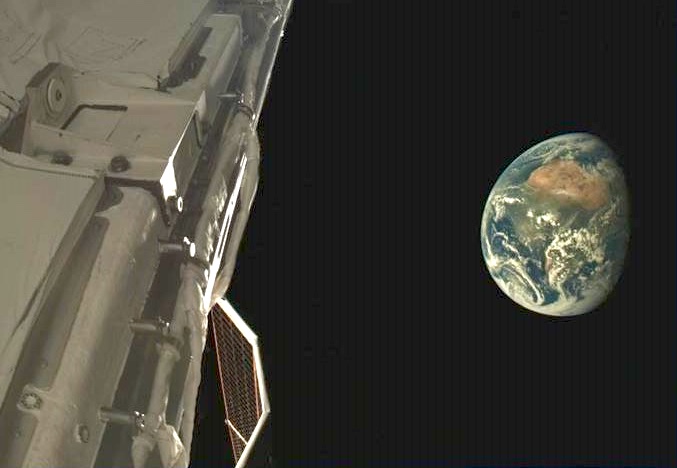
© US Space Force
On February 20, 2025, a new image of Earth, taken from a high Earth orbit (HEO) vantage point, was released. The image itself is not entirely unique, that is compared to other similar images, it is the vehicle from which the image was taken that is causing quite a stir. The image was captured by an onboard camera on what many are referring to as a secretive space plane. While this is partially true and a great way to grab attention, we do have a significant amount of information about this so-called secret space plane.
The vehicle, called the X-37B, is essentially a drone built to withstand long orbital missions. It began as a $192 million project between NASA and Boeing’s California-based security and defense branch, Phantom Works, in 1999. Three years later, an additional $301 million was added to the project. Boeing built the drone as a smaller-scale version of previous space shuttles. The X-37B is 29 feet 3 inches long, 9 feet 6 inches high, has a 14-foot 11-inch wingspan, and a maximum takeoff weight of 11,000 pounds. It is powered by gallium arsenide solar cells and lithium-ion batteries. The uncrewed X-37B has successfully completed six Operational Test Vehicle (OTV) flights, the longest of which was 908 days in orbit, and is currently on its 7th flight, OTV-7.
In 2004, NASA transferred the X-37B program to the United States Department of Defense. Today, the drone is operated by the Department of the Air Force’s Rapid Capabilities Office in collaboration with the United States Space Force. The drone is vertically launched from a launch vehicle and, upon its return to Earth, lands horizontally on wheels like an airplane. For OTV-1, the drone was launched on April 22, 2010, from an expendable Atlas V rocket in Cape Canaveral, FL. The X-37B spent 224 days autonomously in low Earth orbit (LEO) for this trial flight. Upon deorbiting and landing, the drone suffered a tire blowout and minimal damage to the vehicle’s underside.
Subsequent flights were launched from Atlas rockets, with the exception of OTV-5, which was launched from a partially reusable Falcon 9 launch vehicle, and the current flight. OTV-7 was launched on December 29, 2023, using a partially reusable Falcon Heavy launch vehicle. The drone’s expected deorbiting date has not yet been announced, nor has any mention of an OTV-8 follow-up flight. However, each launch of the X-37B has been roughly one year after its return to Earth. So, while we have a good amount of information on the X-37B’s provenance and operational history, what exactly it is being used for is still shrouded in mystery.
Chief of Space Operations General Chance Saltzman has said that one of the primary goals of the X-37B program is to develop a cost-effective, reusable space vehicle. As space exploration becomes more competitive and congested, having an exploratory vehicle that can be used for years, returning to Earth multiple times, and fitting within a nation’s budget is important. General Saltzman also revealed that one of the biggest achievements of the drone program has been the development of patented anti-collision technology. Though he did not specify whether this technology would be used for Earth-bound vehicles, its implications could position the United States with a stronghold in dominating LEO and HEO navigation.
The drone is equipped with an array of cameras and sensors that send data back to Earth on the aforementioned anti-collision protocols, as well as radiation, maneuverability, and much more. The image released of Earth was taken from one of the X-37B’s cameras that monitors the drone’s health. It is the first image ever released from the vehicle while in orbit. With the image release, the program also announced that the drone was preparing to test aerobraking maneuvers that would allow it to use the drag of Earth’s atmosphere to alter its orbital direction.
The image and tidbit of information about aerobraking are some of the most concrete mission data revealed about the X-37B. So, it’s understandable why many refer to it as a “mystery space plane.” As of the date when the image was made public, the X-37B has spent a cumulative 4,194 days orbiting Earth. Despite the ongoing secrecy surrounding its full capabilities and mission objectives, the X-37B continues to push the boundaries of space exploration. With its successful series of flights, ongoing advancements in technology, and potential future uses, it remains one of the most intriguing and enigmatic assets in the United States’ space arsenal.
|